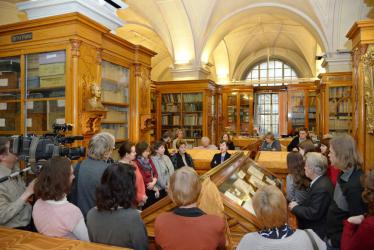First Half of the 19th Century: Trophies, Gifts, Collections
The opening of the first Public Library had a great impact on society in Russia: amateurs and scientists, missionaries, diplomats, and military men were inspired to collect antiquities. It may be no surprise that the Library acquired some valuable collections. Thus, in 1817, the Library bought 160 Old Russian and 65 Eastern manuscripts among other items from the collection of the mining engineer Pyotr Frolov.
The largest acquisitions of Oriental manuscripts became possible due to the successful action of the Russian Army in its campaigns against Persia and Turkey. The Ardebil, Akhaltsikh, Erzerum and Adrianopolis Collections number 420 Persian, Arabic and Turkish manuscripts. The Ardebil Collection stands out by its high artistic merits. It contains 166 exquisitely decorated Persian manuscripts ranging from the 14th to 18th centuries. These lavishly illstrated volumes were held in the library at the tomb of the founder of the Safavid dynasty, Sheikh Safi (this military trophy was paid in gold).During these years, by order of Nicholas I, about 350 Muslim manuscripts were transferred into the Depository, including manuscripts brought to St. Petersburg by the grandson of Fath Ali Shah, Prince Khosrow Mirza. He headed the mission sent by Fath Ali Shah to apologize for the murder of the Russian diplomat and play writer Alexander Griboedov in Tehran.
Further growth of the manuscript stock became possible due to the results of years of collecting by diplomats (I.O. Simonitch, D.I. Dolgoruky, A. Zhaba), Russian and foreign scholars (V.D. Smirnov, I.P. Minaev, N.V. Khanykov, K. Tischendorf, J.-J. Marcele) and missionaries (Archimandrite Peter (Kamensky), Archbishop Porphyrius (Uspensky), Archimandrite Antonin (Kapustin), Z.F. Leontievsky). The largest private collection is that of the Karaite traveler, merchant and archeologist Avraam Firkovich, numbering some 18 000 items as well as the personal papers of its owner.
In 1831, Archimandrite Peter (Kamensky), the head of the Russian Ecclesiastical Mission in China, donated 48 Chinese, Manchu, Mongolian manuscripts and xylographs with translations of Christian writings. He brought them from Beijing at the request of A. Olenin, then Director of the Library.
It should be noted that, for lack of the budgetary resources of the Library, the most expensive collections were purchased by the Government. This tradition originated under Alexander I and was continued under Nicholas I and Alexander II. For instance, 1,302 Old Russian manuscripts gathered by Count Fyodor Tolstoy were bought for the Library in 1830.
In 1836, the Library acquired a collection of Count Pieter van Suchtelen, a Russian General of Danish origin and an envoy of the Russian Empire at the Swedish court. The hand-written part of this magnificent and very extensive collection consisted of about 250 manuscripts in Western European languages, ranging from the 10th to 19th centuries. In addition, it includes 40 thousand documents dating from the 15th to 19th centuries, which form 3 large sets of materials. These are:
- The collection of autographs of the rulers of various states and their families, high officials, military leaders, scientists and literature figures;
- Archive of Abbot A.Caloger, a representative of the Italian Enlightenment, Venetian publisher and philologist;
- Archive of the Kingdom of Westphalia, established in 1807 as a sovereign state. It was ruled by Napoleon's brother Jérôme Bonaparte and existed until 1813.
